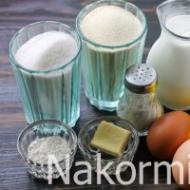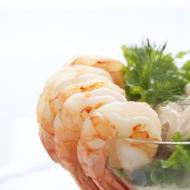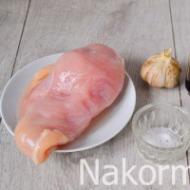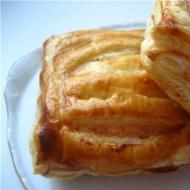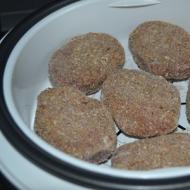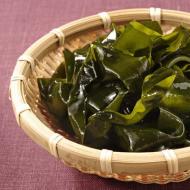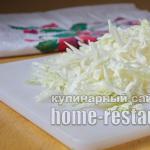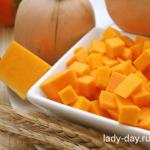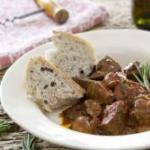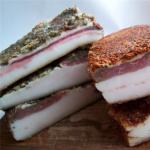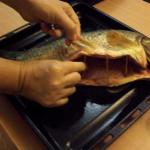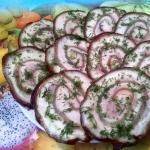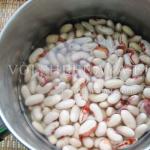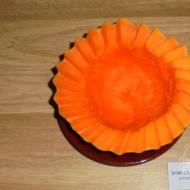
There must be Kulich. Signature recipes for Easter cakes from the best chefs in Voronezh! Rules and secrets of making Easter cake
Every holiday has traditional dishes. It’s hard to imagine the New Year’s menu without Olivier, and on March 8th - without Mimosa salad. Likewise, the Easter table is traditionally decorated with colored eggs, Easter cake and Easter cottage cheese. A good housewife will never ask where to buy Easter cake. She herself will happily tell you how to bake Easter cake, and in more than one way.
A little history
Easter, like any other holiday, has its own story, which tells the origin of its symbols and explains their meaning. Kulich is a round-shaped butter bread that decorates the Easter table. It was baked precisely round, because the shroud of Jesus Christ had a similar shape. Kulich must certainly be rich, because according to legend, before the death of Jesus, he and his disciples ate unleavened bread, and after the miraculous resurrection they began to eat yeast bread (leavened). Since then, it has become a custom to make dough for Easter cakes.

When planning to make your own Easter cake, take note of a few tips:
- the butter should not be hard, then the cake will be soft and tender;
- the butter should soften on its own at room temperature, not when heated;
- you can use paper molds made specifically for baking Easter cakes;
- You can use a tin can as a form. But in this case it must be lined with oiled baking paper;
- baking paper can be replaced with the usual one used in offices. But it must be properly lubricated with oil;
- To prevent the dough from sticking to your hands, moisten them with water or vegetable oil;
- The readiness of the Easter cake is checked with a splinter or a thin skewer, which is stuck into the Easter cake. If it is dry, the cake is ready;

Easter Kulich traditional
- 1 kg of wheat flour;
- 6 eggs;
- 1.5 glasses of milk;
- 300 gr. margarine (or butter);
- 1.5 cups sugar;
- 40 gr. yeast;
- dried fruits and nuts (150 grams of raisins, 50 grams of candied fruits and almonds).
- 0.5 packets of vanilla sugar;
- salt;
Preparation:
- Lightly heat the milk and dissolve the yeast in it.
- Add half of the indicated portion of flour. Stir. The dough is ready.
- Cover the bowl with the dough with a towel and place in a warm place.
- The dough should be left to rise until its volume doubles.
- Separate the yolks and whites. Beat the yolks with vanilla and sugar, beat the butter.
- Add salt, yolks and butter to the dough. Mix everything.
- Beat the egg whites until they form a thick, elastic foam. Add them to the dough.
- Add the remaining flour. The resulting dough should freely lag behind the walls of the dish. It should not be too steep and well kneaded.
- Cover the dough again and leave in a warm place until it has doubled in size.
- Wash the raisins, dry, roll in flour. Cut the candied fruits into squares. Peel the nuts and chop them. Add dried fruits and nuts to the risen dough.
- Prepare a mold (with a round bottom!): line the bottom with oiled baking paper, grease the sides with butter and sprinkle with flour. Fill the form 1/3 full with dough.
- Leave the dough to rise. It will be ready to go into the oven when it has risen halfway up the pan.
- The oven should not be too hot. Leave the mold in it for 50 minutes to 1 hour. Carefully rotate the pan as it bakes. If the top browns early, cover it with paper soaked in water to prevent it from burning.
Decorate the finished cake with chocolate, candied fruits or nuts.

Quick cake
Many housewives, especially those busy at work or with small children, are concerned with the question of how to bake Easter cakes with the least amount of time. The recipe below is easy to prepare and saves effort.
You will need:
- 1 glass of milk;
- 4 eggs;
- 1 tbsp. l. dry yeast (or 50 grams of fresh);
- 1 cup of sugar;
- 2 tbsp. l. vegetable oil;
- 100 gr. butter;
- 3 cups flour;
- vanillin;
- raisins, candied fruits.
Preparation:


- Warm the milk.
- Add yeast and sugar (only 1 tbsp) to warm milk. Stir and leave for 15 minutes so that they “make friends.”
- Beat the eggs with the remaining sugar and vanilla.
- Melt the butter and add it to the dough. Add vegetable oil, yeast and stir well.


- Add washed and dried raisins and candied fruits.
- Gradually stir in the sifted flour. The dough should be pourable.
- Divide the dough into the molds. It will rise, so the dough should take up no more than 1/3 of the mold.
- Leave the dough in the molds for 3-4 hours - during this time you can get down to business.


- Place the molds in a hot oven (t=180 degrees). Bake the cake until done.
- Decorate the finished cake with icing and confectionery beads.

Easter cake without yeast and eggs
There are a lot of recipes on how to bake a delicious Easter cake. It turns out that it can be prepared without yeast, milk and eggs.
You will need:
- 240 gr. flour;
- 2 tsp. baking powder;
- 0.5 cups brown sugar;
- 1 banana;
- 40 ml juice (pineapple);
- 180 ml water;
- 50 gr. raisins;
- salt;
- 3 tbsp. l. vegetable oil.
Preparation:
- Mash the banana to make a puree.
- Add oil, water, juice. Stir.
- Add salt (a pinch) and baking powder.
- Gradually sift the flour into the dough, stirring it constantly.
- Knead into a sticky dough.
- Fill the molds with it so that the dough occupies 3/4 of the volume of the mold.
- Bake the cake in the oven preheated to 200 degrees for about 50 minutes. The time depends on the oven.
- The finished cake should be removed from the mold when it has cooled. Decorate it with icing and other decorations.

The beauty of making your own Easter cake is that homemade Easter cake can be prepared not only according to the traditional recipe, but also using, for example, sour cream.
You will need:
- 200 gr. sour cream;
- 1 tsp. dry yeast (or 25 g fresh);
- 170 ml milk;
- 50 gr. butter;
- 150 gr. Sahara;
- 650-700 gr. flour;
- 3 eggs;
- 2-3 tbsp. l. cognac or rum;
- 50 gr. raisins;
- nuts for sprinkling;
- vanillin.
Preparation:
- Pour rum or cognac over the raisins.
- Dilute the yeast with some warm milk - pour 2 tbsp. l. milk, they will come in handy later.
- Separate the white from the yolk in one egg. Beat two eggs and the white of the third with sugar and sour cream.
- Combine everything in one bowl, stir, add salt and gradually add flour.
- The dough should be soft and slightly sticky. Cover it with a towel and leave for half an hour.
- After half an hour, add soft butter to the dough and stir. Cover again with a towel and leave for one and a half to two hours.
- Knead the dough lightly and add the squeezed raisins. Knead the dough so that the raisins are evenly distributed throughout the dough.
- Divide the dough into the molds and leave until doubled in size.
- Mix the yolk with 2 tbsp. l. milk and brush the top of the cake with the mixture. Chop the nuts and sprinkle them on the cake.
- Place in the oven (t=200 degrees) for 30 minutes until done.

Decorations help make the cake truly festive: icing, marmalade, multi-colored confectionery beads, nuts, marzipan, candied fruits, fruit figures. When talking about Easter cake, one immediately thinks of lush round bread with a white top. This is the icing. The following recipe answers the question of how to make icing for Easter cake.
You will need:
- 1 egg white;
- 100 gr. sugar (fine);
- salt (pinch).
Preparation:
- Cool the whites and beat with salt until elastic foam is obtained.
- Without stopping whisking, add sugar.
- Continue beating for another 4 minutes after the sugar runs out.
- When the cake has cooled slightly, spread the glaze on it and leave until hardened.
Easter dishes prepared with your own hands not only give a great taste and delight with a festive appearance, but also carry a positive charge, being filled with feelings and good wishes of the hostess.
TO Ulichi is Easter bread, which must certainly be consecrated.
Ancient Russian cuisine knows about 20 types of Easter cakes. Easter cakes, both large and small, can be of varying degrees of richness, but they should all be high.
Easter cake dough differs from regular baking in that a lot of eggs, butter and sugar are placed in it, and during the baking process it rises more than 2 times. Typically, tall cylindrical pans are used for traditional Easter cupcakes. To prepare a denser cake, fill the mold by half, and for a more fluffy one - by a third.
In order to bake a good Easter cake, you need good yeast, good dry flour and a hot oven (oven). You should also not blindly adhere to the indicated portions of flour, since flour comes in different grades and varying degrees of dryness. However :
♦ Easter cakes can be baked in any shape. The classic shape of Easter cake is round;
♦ in the room where the dough is kneaded, the temperature should not be lower than 25 ° C;
♦ flour should be dry and sifted;
♦ the dough should not be liquid, because in this case the cakes will spread and be flat; if the dough is too thick, it’s also not good: the cakes will be too heavy and tasteless and will soon become stale. The dough should be so thick that it can be cut with a knife without adding flour. It should not reach for the knife;
♦ you should knead the dough and beat it out as long as possible so that it completely comes off your hands and from the dishes or table surface;

♦ The dough should rise three times:
- the first time it is dissolved - the dough is suitable (at 28-30 ° C);
- the second time when it is kneaded - after adding all the ingredients according to the Easter cake recipe
- the third time - already in the mold or on a baking sheet (at 30-45 ° C);
♦ You can add raisins, nuts, and spices to the finished dough. If you want the cakes to turn out white, do not use spices. Cardamom, ginger, and nutmeg make the dough darker; saffron turns it yellow. But with spices, the cakes are more aromatic. By mixing different spices, you can achieve a simply magical smell. Cinnamon makes the dough very dark, and the smell of cinnamon overwhelms other aromas and does not allow for a subtle range;
♦ Alcohol in Easter cakes is needed not only for flavor, it affects the consistency of the dough. Of all the alcohol additives, the best is the Italian liqueur Amareto di Sarona;
♦ Do not leave Easter cake dough in a draft. It doesn't like it. It should be used in a warm room.
♦ The baking dish should be filled halfway with dough. It rises a little in the pan and then you can put it in the oven.
♦ To ensure that the Easter cake rises evenly, before putting it in the oven, insert a small wooden stick into its middle.
♦ To ensure that the cake does not burn and stays well behind its shape, a circle of oiled white paper is usually placed on the bottom, and the walls are generously greased with oil and sprinkled with flour. After the cake has browned, you can also protect its upper part from charring with a circle of paper dipped in water or a circle cut out of tracing paper.
♦ You need to put the Easter cakes in a hot oven (oven) and keep it closed; The oven should be well heated to 200 degrees. Don't cram too many pans into the oven, and don't let the pans touch each other. If you are baking a large cake, place a couple more small ones in the corners of the oven, and that’s enough. Bake the cakes for approximately 40 minutes (time depends on the oven and the size of the pan);
♦ bake the cake in a humidified oven; to do this, place a container of hot water on the bottom; temperature 200-240° C;

♦ when the cake rises, you need to grease it on top with an egg, previously beaten with a spoon of water and sunflower oil, do not grease the sides, then sprinkle with chopped almonds, coarse sugar and breadcrumbs;
♦ to check whether the Easter cake is ready or not, use a wooden stick - stick it into the baked product: if the dough sticks to it, then the Easter cake is still raw; if the stick turns out to be completely clean, then the cake is ready;
♦ The duration of baking the Easter cake depends on its size. Easter cakes weighing less than 1 kilogram are baked for up to 30 minutes, 1 kilogram - 45 minutes, one and a half kilograms - 1 hour, 2 kilograms - one and a half hours.
♦ When the cake is ready, take it out of the oven and place it on its side so that the bottom comes off
♦ Don’t forget to cover your wonderful cakes with a towel after finishing baking!
by Notes of the Wild MistressThere must be Easter cake on the festive table on Easter. Kulich is Easter bread, which must certainly be consecrated on the eve of Easter. Ancient Russian cuisine knows about 20 recipes for baking Easter cakes. Kulich, both large and small, can be of varying degrees of richness, but it must be tall and fluffy.

In order to bake for Easter, you need good yeast, good dry flour and a hot oven (oven). When baking Easter cake, you should not blindly adhere to the flour proportions specified in the baking recipe, since flour comes in different grades and varying degrees of dryness. However, when preparing Easter cakes, there are a number of rules that must be followed in order to get a beautiful, fluffy and tasty Easter cake for Easter:
Easter cake can be baked in any shape. The classic shape of Easter cake is round;
In the room where the Easter cake dough is kneaded, the temperature, in accordance with the baking recipe, should be at least 25°C;
Flour for Easter cakes should be dry and sifted;

The dough for Easter cake should not be liquid, because in this case the Easter cake will spread and be flat;
If the dough is too thick, it’s also not good: the cakes will be too heavy and tasteless and will soon go stale. The Easter cake dough should be so thick that it can be cut with a knife without adding flour. It should not reach for the knife;
You should knead the Easter cake dough and beat it out for as long as possible so that it completely comes off your hands and from the dishes or table surface;
The dough for Easter cakes should be suitable three times: the first time when it is dissolved (at 28-30 ° C), the second time when it is kneaded, and the third time - already in the mold or on a baking sheet (at 30-45 ° C);

You can add raisins, nuts, and spices to the prepared Easter cake dough according to the baking recipe. If you want the Easter cakes to be white, do not use spices. Cardamom, ginger, and nutmeg make the cake dough darker; saffron turns the cake yellow. But with spices, the cakes are more aromatic. By mixing various spices when preparing Easter cakes, you can achieve a simply magical smell. Cinnamon makes the Easter cake dough very dark, and the smell of cinnamon overpowers other flavors and does not allow for a subtle range;
Alcohol in Easter cakes is needed not only for flavor, it affects the consistency of the dough. Of all the alcohol additives in Easter cakes, the best is the Italian liqueur “Amareto di Sarona”;

Place the cakes in a hot oven (oven) and keep it closed. The oven for baking Easter cake should be well heated to 200 degrees. Don't stuff too many cake pans into the oven, and don't let the pans touch each other. If you are baking a large cake, place a couple more small cakes in the corners of the oven, and that’s enough. Bake the cakes for approximately 40 minutes (time depends on the oven and the size of the pan);
The cake is baked in a humidified environment; to do this, place a container with hot water at the bottom of the oven, temperature 200-240 ° C;
When the cake rises, you need to grease it on top with an egg with a spoon of water and butter, do not grease the sides, then sprinkle the cake with chopped almonds, coarse sugar and breadcrumbs;

To check whether the Easter cake is ready or not, use a wooden stick - stick it into the baked product: if the dough sticks to it, then the Easter cake is still raw, but if the stick is completely clean, then the Easter cake is ready
The duration of baking the Easter cake depends on its size. If the cake burns on top, cover it with damp paper or a circle cut out of tracing paper.
Don’t forget to cover your wonderful cakes with a towel after finishing baking!
Hello, dear hostesses!
Kulich is an Easter holiday cake. The custom of baking Easter cakes, painting eggs and exchanging them on Easter has been preserved among the people to this day.
When preparing EASTER Easter cake, many housewives often have questions: HOW TO DO IT RIGHT? WHAT EXACTLY? WHY? WILL IT WORK?...
Today I will share with you the verified “golden rules” that are followed in our kitchen when preparing Easter cake.
I will share the information that I own and use myself.. Maybe it will be useful to someone!When baking Easter cakes, you need to remember the following:
FLOUR
· Amount of flour necessary to obtain a good dough depends on the quantity and quality of the liquid components, i.e. milk, kefir, curdled milk, their density, the freshness of the yeast, the moisture content of the fats, as well as the quality of the flour itself. Flour must be of the best grades.
· The flour must be dry. Put the flour on the radiator in the evening, excess moisture will go away.
· Before kneading the dough, the flour should be sifted several times, At the same time, it is saturated with oxygen, and the resulting dough will be fluffy and tender.
This flour produces a fluffy and light dough.
YEAST
· It is better to use fresh, light yeast with a pleasant yeasty smell.
Yeast is diluted with warm (!) milk or warm (!) water, adding sugar to activate it. Cold milk (water) slows down the activity of yeast fungi, and hot milk leads to complete suppression of their activity.
· if the yeast is not fresh, it must be “activated”.
To do this, finely crumble and dilute in 0.5 cups of warm milk, add 1 - 2 teaspoons of sugar, stir and leave for 10-15 minutes: The appearance of bubbles and foaming indicate the activity of the yeast, therefore, the possibility of using it.
MILK
· It is best to use milk to make Easter cake. It improves the viscoplastic properties of the dough and enhances the loosening process.
· Milk It is best to bring to a boil and cool to room temperature.
· Instead of fresh milk for yeast dough you can use sour milk, yogurt, kefir, buttermilk, sour cream, cream, whey and other fermented milk products.
FATS
· Fats ensure the plasticity of the dough, give the finished product fragility, tenderness, aroma, and prevent staleness.
· The amount of fat added to the dough should not be exceeded as specified in the recipe. , since excess fat impedes the work of yeast, as a result of which the loosening of the dough is reduced or completely stopped, while the ability of flour proteins to swell is limited, the dough becomes torn, difficult to shape, and the finished product is tasteless.
· Butter must be the latest. Before adding it to the dough, you need to melt it, let it sit, then pour the warmest, purest (without suspensions) into the dough.
· If you add vegetable oil to the dough , then the cake stays fresh longer.
· So that the dough is viscoplastic, elastic, tear-resistant, light and convenient for cutting and shaping, it is recommended to add both butter and vegetable oil.
EGGS
· Eggs (especially protein) impart rigidity and hardness to the dough; products made from such dough quickly become stale.
· If you decide to add to the dough whole eggs, then it’s better to spend 3-4 minutes and beat the whites and yolks separately, as for a sponge cake. In this case, the Easter cake will turn out more fluffy and tender.
· Yolks It is necessary to carefully separate from the proteins, strain through a sieve and only then thoroughly beat them until white.
· For whipping proteins Porcelain or copper cookware should be used, but not aluminum. It should be dry and clean. Whisk squirrels slowly at first, gradually increasing the pace and without breaks. Whipped squirrels add to the dough while stirring gently. If you stir intensively, the proteins “settle” and the dough product turns out dense and unbaked;
SALT
· Coarse salt is dissolved in the liquid on which the dough is kneaded. Fine salt is placed directly into the dough, which is prepared without liquid. However, you should not add salt directly to the dough - it kills yeast.
· WHEN CONNECTING MIXTURES WHEN KNEADING THE DOUGH, ADD THE LIGHT MIXTURE TO THE HEAVY MIXTURE, BUT NOT THE VICE VERSE!
CANDIED FRUIT
Soak watermelon, melon, pumpkin or citrus peels in cold water for 3-4 days, then pour in thick sugar syrup and cook like jam. Then remove the candied fruits from the syrup and sprinkle with powdered sugar. Store them in a tightly closed container.
SAFFRONVO - OIL MIXTURE
The dough will have a bright yellow color and a characteristic aroma if it is tinted with saffron tincture. Thoroughly grind the dry saffron stamens, pour a glass of vodka over them and place them in a dark, dry place for 14 days. Store the tincture in a tightly closed glass bottle. And when you prepare the dough for the Easter cake, dilute a few drops of saffron tincture in 1 tsp. boiling water, add 1 tbsp. l. melted butter and mix well.
DOUGH
· Easter cake loves heat , so avoid drafts while kneading and resting the dough.
· It is better to knead the dough with a wooden spatula, in this case it will turn out fluffy and airy.
· Easter cake dough should not be liquid (the cakes will spread and be flat) and should not be thick (the cakes will be too heavy and will quickly become stale).
· The cake dough is kneaded for as long as possible so that it completely lags behind your hands or the table.
· The dough must rise three times : first time the dough is suitable, second time- when all products have been added, the third time- when the dough is placed in molds.
BAKING DISH
· Forms can be tin, copper, cardboard and have different shapes.
· Baking pans are greased with oil and the bottom is covered with oiled foil.
· The pan for baking Easter cakes is filled only halfway with dough, allowed to rise to 3/4 of the height of the pan, and then placed in the oven.
OVEN
· The oven must be preheated well. The baking temperature for Easter cakes should be = 180°.
· At a temperature of 200-220 degrees, bake the Easter cake in a humidified oven (to do this, place a container of water down).
· On average, an Easter cake weighing less than 1 kg is baked for 30 minutes, weighing 1 kg - 45 minutes, weighing 1.5 kg - 1 hour, weighing 2 kg - 1.5 hours.
· To ensure that the cake rises evenly, a wooden stick is inserted into the center before baking. After a certain time, the stick is removed. If it is dry, the cake is ready.
· If the cake starts to burn on top, cover it with dry paper or foil.
· The finished cake is removed from the oven, placed sideways on a pillow and left in this position, periodically rolling until completely cooled. At the same time, the cake “ripens”.
GLAZE
The Easter cake, ready for baking, is brushed with an egg beaten with 1 tbsp. spoon of water and butter, sprinkle with nuts, coarse sugar and breadcrumbs.
Ready-made Easter cakes can be glazed with any glaze or fondant.
For glaze: 1
Beat 2 egg whites with 200 g of powdered sugar until a thick, airy mass is obtained and add lemon juice to taste.
For glaze: 2 (custard protein cream)
· 3 egg whites,
· 1 cup of sugar,
· 0.5 cups of water (or a little more),
· 1 teaspoon lemon juice (citric acid).
Method for preparing custard protein cream:
To prepare the glaze, add water to the sugar (the water should slightly cover the sugar), stir and keep over high heat, stirring constantly and skimming off the foam, until the liquid thickens. To test for readiness, scoop out some syrup and place it in cold water. If the cooled syrup can be formed into a soft ball, it is ready. Remove from heat and add lemon juice. Mix. If you are using citric acid, it should be added at the beginning of preparing the syrup. It is added so that the syrup does not darken when boiling.
Separately, beat the egg whites until they increase in volume by 3-4 times. Pour hot syrup in a thin stream and continue whisking without ceasing until smooth. After cooking, the glaze (custard protein cream) can be applied to the prepared Easter cake.
If the cakes have become stale, you can refresh them , cut off the top layer, moisten with a small amount of syrup:
· a glass of strong wine,
· a glass of water,
· a full tablespoon of sugar
mix, heat and soak the cake with the prepared syrup. Then put it in a hot oven for 15-20 minutes (you can wrap the product in parchment paper). The cake will become tastier as it will become saturated with flavor.
I wish you success!
Anna Andreeva learned to bake Easter cakes from her mother and grandmother. Now every year she prepares them in the Kazan Bogoroditsky Monastery and at home.
The cook of the Kazan Mother of God Monastery, Anna Andreeva, shared the recipe for Easter cake. Photo: AiF / Aliya Sharafutdinova
Where did the tradition of baking Easter cakes come from?
The word “Kulich” goes back to the Greek “kollikion” - a sweet, buttery tall round bread, similar to artos (Greek Άρτος, bread) - tall bread consecrated with leavened (yeast) bread, also called “whole prosphora” (that is, without removed particles) . The artos depicts the Cross and the crown of thorns - symbols of Christ's victory over death, His Resurrection.
Kazan Bogoroditsky Monastery. Photo: AiF / Aliya Sharafutdinova
In the Orthodox Church, artos is consecrated during the liturgy on the first day of Easter. Throughout Bright Week he stands in the church on a lectern in front of the Royal Doors, and during services - in front of the icon of Christ. During the Procession of the Cross, which takes place every day of this week, it is carried around the temple. On Bright Saturday, as in the ancient church, after the liturgy, the artos is broken up with prayer and distributed to everyone present in the church.
What should a real Easter cake be like?
Easter cakes were always baked from yeast dough, tall and always in the shape of a cylinder.
Jesus and his disciples on Passover, Holy Week, ate only unleavened bread - unleavened bread. When they shared a meal after Christ's Resurrection, leaven was already allowed, so Easter cake - the bread of joy - is baked high-risen and rich, with the addition of a large number of eggs, milk butter, and raisins.
When purchasing, you must choose a blessed Easter cake. Photo: AiF
Believers consider Easter cake a symbol of new life and resurrection. You should not start baking Easter cakes in a hurry or in a bad mood. They used to believe that the family’s entire year would depend on how the Easter cake turned out. If it is beautiful, even and smooth, then the year will be successful. Cracked and crooked Easter cake - to disappointments and losses.
How to cook Easter cake at home
The cook of the Kazan Bogoroditsky Monastery, Anna Andreeva, shared her recipe for Easter cake.
“Easter cakes prepared according to old recipes turn out tasty and do not spoil. Previously, the dough for Easter cake was kneaded on the night from Thursday to Friday, baked throughout Friday, and on Saturday the cake was taken to church for blessing. Preparing such a delicacy is a special process. At this time, there should be peace and cleanliness in the house and in the soul,” says the craftswoman.
Easter cake recipe
For the test:
1 glass of milk,
800 grams of flour,
200 grams of butter,
1.5 cups granulated sugar,
50 grams of yeast,
- ½ teaspoon salt,
150 grams of raisins,
50 grams of candied fruits,
1 packet of vanilla.
For the glaze:
2 tablespoons sour cream,
4 tablespoons sugar,
20 grams of butter.
Opara
The dough is made from one glass of warm milk, 50 grams of yeast and 400 grams of flour.
Mix the ingredients and leave at a temperature of 28-30° C for several hours. The dough should ferment and rise 2-3 times. After this you can knead the dough.
“When setting the dough and kneading the dough, the housewife should read prayers and ask God for a good, tasty cake for her family,” admits Anna Andreeva.
Easter cake dough
Take 4 or 5 eggs at room temperature, separate the yolks from the whites. Mix the yolks with 1.5 cups of sugar and a pack of vanillin, beat the whites into a foam. Add all this to the dough. Add ½ teaspoon of salt.
You need to heat 200 grams of butter or margarine. We also add butter to the dough. Pour in the remaining 400 grams of flour.
Knead the dough until it begins to pull away from your hands.
The dough needs to be kneaded until it begins to lag behind your hands. Photo: AiF / Aliya Sharafutdinova
Cover the pan with a lid and place the dough in a warm place: it should rise to double.
“After an hour, add additional ingredients to the cake. These can be raisins, nuts, candied fruits, honey, lemon zest, chocolate, various spices (cardamom, nutmeg, cinnamon, cloves, vanilla). I put 150 grams of raisins and 50 grams of candied fruits in the dough,” explains the chef.
Baking Easter cake
Kulich is baked in special forms.
Easter cakes are baked in special forms. Photo: AiF / Ksenia Zheleznova
“You need to cut out strips of parchment and line the sides and bottom of the molds with them. Coat the inside of the parchment with oil. Fill out ½ or 1/3 of the form. Place the cake in an oven preheated to 180°C. Bake for about 40 minutes. We check the readiness of the baked goods with a stick - it should be dry,” says the chef.
Icing for Easter cake
Mix 2 tablespoons of sour cream, 20 grams of butter and 4 tablespoons of granulated sugar and cook over low heat until thickened.
Apply glaze to the cake. Photo: AiF
When the cake has cooled, you can pour glaze over it.
Decorating the Easter cake
Decorating the Easter cake also has a special meaning. Traditionally, nuts and raisins are laid out with an image of a cross or the letter: “ХВ” - Christ is Risen. In most cases, housewives decorate the Easter cake with powdered sugar, poppy seeds or special confectionery sprinkles.

Traditionally, nuts and raisins are laid out with an image of a cross or the letter: “ХВ” - Christ is Risen. Photo: www.russianlook.com
How is Easter cake blessed?
Every year, after the morning service on Holy Saturday (sometimes after the night holiday service), Easter cakes are blessed in churches. The priest sprinkles the holiday food brought by the believers with holy water.
“Easter cake must be blessed. We eat this kind of cake throughout the week,” says Anna Andreeva.
How should you eat Easter cakes?
During the 49-day fast, the human body gets used to light food. To avoid harm to health, you should not overeat.
Easter cakes are served at the festive table. The Easter cake is cut to form circles. The hat is left until the entire cake is eaten. It covers the incised part.
“It is impossible to imagine the Resurrection of Christ without traditional treats that mark the holiday. Good luck with your Easter cakes,” wishes Anna Andreeva.

